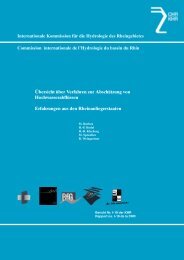ABSTRACTS 'Extreme Discharges' - CHR-KHR
ABSTRACTS 'Extreme Discharges' - CHR-KHR
ABSTRACTS 'Extreme Discharges' - CHR-KHR
You also want an ePaper? Increase the reach of your titles
YUMPU automatically turns print PDFs into web optimized ePapers that Google loves.
Extreme discharges in the Meuse basin<br />
Marcel de Wit 1)<br />
Robert Leander 2)<br />
Adri Buishand 2)<br />
1)<br />
Institute for Inland Water Management and Waste Water Treatment (RIZA)<br />
P.O. Box 9072, NL 6800 ED Arnhem, the Netherlands<br />
2)<br />
Royal Dutch Meteorological Institute (KNMI)<br />
P.O. Box 201, NL 3730 AE De Bilt, the Netherlands<br />
m.dwit@riza.rws.minvenw.nl<br />
Introduction<br />
Over the last years the frequency and magnitude of floods of the river Meuse have been relatively large.<br />
These floods have caused a lot of trouble and triggered the design of national and international flood action<br />
plans. The recent floods have also generated many valuable observations of extremes. This presentation<br />
consists of i) a description of the river Meuse basin, ii) an impression of observed extremes, iii) an<br />
overview of ongoing research to derive the design discharge and scenarios for future extreme discharges<br />
of the river Meuse, and iv) a brief overview of the ongoing measures in the Meuse basin<br />
that aim at a reduction of flood risk.<br />
The Meuse basin<br />
The Meuse basin (Figure 1) covers an area of approximately 33,000 km 2 , including parts of France,<br />
Luxembourg, Belgium, Germany, and the Netherlands.<br />
The Meuse basin has a temperate climate, with rivers that<br />
are dominated by a rainfall-evaporation regime, which<br />
produces low flows during summer and high flows during<br />
winter. The Meuse basin can be subdivided into three<br />
major geological zones: i) the Lotharingian Meuse<br />
(upstream of Charleville-Mézières). This part of the Meuse<br />
basin mainly consists of consolidated sedimentary Mesozoic<br />
rocks, ii) the Ardennes Meuse (between Charleville-Mézières<br />
and Liège). Here the river transects the Paleozoic<br />
rock of the Ardennes Massif, and iii) the lower reaches<br />
of the Meuse (downstream of Liège). The Dutch and<br />
Flemish lowlands are formed by Cenozoic unconsolidated<br />
sedimentary rocks. The average annual precipitation<br />
amounts 800 to 900 mm·year -1 in the southern part of the<br />
basin, around 700 to 800 mm·year -1 in the northern part<br />
of the basin and up to 1500 mm·year -1 in the central part<br />
of the basin. The annual average discharge of the Meuse<br />
at the outlet is approximately 350 m 3·s -1 .<br />
Fig. 1 Location of the Meuse basin<br />
Observations<br />
The longest discharge record available for the Meuse is that of Borgharen (upstream area 21,000<br />
km 2 ). From Figure 2 it can be observed that even the average annual discharge of the Meuse shows<br />
strong fluctuations. The average discharge in 1966 is about 6 times larger than the average discharge<br />
in 1976. The Borgharen record also shows that five out of the seven largest floods in the<br />
Meuse have occurred during the last decade. Tu et al. (2004) detected long term changes in precipi-<br />
5





